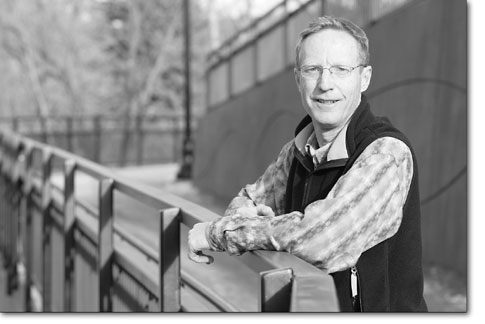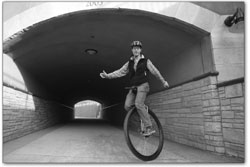| ||||
| 13 years and 1,000s of miles Trails' 2000's Bill Manning reflects on his time in the dirt SideStory: The trail ahead: Mary Monroe eager to fill big shoes
by Will Sands Local singletrack will be missing a prominent Pulaski after this week. Following 25 years in Durango, 13 of them as the director of Trails 2000, Bill Manning is moving on. But as he departs for a job directing the Colorado Trail Foundation, Manning leaves Durango with a lasting legacy carved firmly in the local dirt. Mountain biking was still in its infancy when Durango hosted the first-ever unified World Mountain Biking Championships in 1990. The championships were hugely successful, helping to launch mountain biking as a credible sport and helping to land Durango on the map as a cycling mecca. The event also birthed a group that continues to leave its mark on the local landscape – Trails 2000. Spurred by the championships, Ed Zink, Sally Wiseley and Bob Lillie founded Trails 2000 in 1990. From the get-go, the effort went beyond mountain biking, encompassing all trail users as well as local governments and businesses. The founders’ goal and hope was to have 2,000 miles of trail in place locally by the year 2000. In 1993, Manning was brought on as Trails 2000’s director, a job that was initially unpaid. “Bill was certainly the right guy at the right time to channel and direct the community energy that was developing around trails,” Zink comments, reflecting on Manning’s 13 years with the group. Zink adds that Manning has ably guided Trails 2000 through Durango’s changing times. “We’ve been through several transitions over the years,” he says. “When we first started Trails 2000, it was a few people doing trail maintenance. Now, we’re dealing with extensive planning documents and various governmental entities. It’s a lot different than when Bill first came on, and he has put Trails 2000 through those different stages very effectively.” With his typical modesty, Manning offers that credit to others. “People often pat me on the back and say, ‘Good job, Bill Manning,’” he responds. “But truthfully, Trails 2000’s success is due to the Durango community.” That strong community energy was a big part of Trails 2000 from the very beginning according to Manning. “I came on as director in 1993, and I started working for free because there wasn’t a bank account at the time,” he says. “We learned early on that Durango is a powerful community that really supported trails. It’s for that reason that the group has succeeded.” One of the group’s earliest tasks was inventorying the existing trail system. After the founders and Manning spent dozens of hours poring over maps, the original goal of 2,000 miles by the year 2000 fell by the wayside. “In 1993, we all sat around a table and tried to figure out how to do our very first trail inventory,” Manning recalls. “The San Juan National Forest was so big, we didn’t know where to get started. We didn’t know if Dry Fork Road should be considered a trail. We had maps spread out everywhere, and they all had different trail lines on them. Eventually, we just decided that mileage was unimportant.” The goal immediately changed from quantity to quality. Trails 2000’s mission shifted to updating the existing trail system, one that had been carved out by cattle, timber and mining over the past century. “We changed the focus to modernizing from a trail system that was made by extractive industries, and we planned for enhancements that would benefit recreation,” Manning says.
With this in mind, Trails 2000’s rallying cry has been “Loops, link and connectors. Gentler grade routes and better-maintained tread,” according to Manning. And to that end, the group has been on the ground, installing water bars and swinging Pulaskis and McClouds for the last 15 years. “We’ve been super active every summer, spring and fall with trail work all the way through,” Manning says. “We’ve been organizing volunteers and accomplishing trail maintenance, working with dirt trails for hike, bike and horse.” Though the group is still responsible for keeping much of Durango’s singletrack in the buff, Trails 2000 has spent more and more time at the planning table in recent years. “In more recent years, the community has asked for our guidance more and more in trail planning,” Manning says. “We’ve been involved in city, county and federal lands planning efforts, and increasingly we’ve helped with the urban and suburban trail system, like the Animas River Trail and the future SMART 160 path.” Looking back at the last 13 years, Manning and Trails 2000 have a long list of accomplishments on the resumé. Manning looks to Durango’s west and east sides for two of his proudest achievements. The Durango Mountain Park is 271 acres laced with trails on the city’s west side. Also known as the Test Track, the park was preserved in 1996 and was groundbreaking as a first major open-space acquisition. “We’re really proud of our open-space preservation in the Durango Mountain Park,” Manning says. “A lot of people don’t know it, but Trails 2000 initiated that open-space project. It’s interesting to think that the existence of those trails is what enabled us to succeed in preserving that acreage.” On the other side of the valley, Manning views the Horse Gulch and Grandview Ridge trail system as the biggest feather in Trails 2000’s cap. Again, Manning credits community members for making both projects possible. “Another special source of pride is the Horse Gulch and Grandview Ridge trail system,” he says. “It is highly utilized, and people value it so much because it’s right out their back door. But, our success with both these projects has come from community support.” The list of accomplishments goes on from there to include ongoing maintenance on the local stretch of the Colorado Trail; the creation of the Dry Fork loop; permanent legal access to the East Animas climbing area; helping to link up the Animas River Trail; and getting the SMART 160 project, which plans to extend the River Trail as far as Bayfield, off the ground, among other things. Looking to the future, Manning sees many formidable challenges for local trails and trail users. However, a recipe that’s heavily flavored with community energy and involvement is sure to guarantee good results. “Trails 2000 was a little different right from the start in that we were a trails group,” he says. “We weren’t just hikers, horseback riders or mountain bikers. We were some of each.” And as Manning rides off into the sunset, he is looking to a new generation of volunteers to keep the spirit of Trails 2000 alive and kicking. “Those folks that were there and built the first trails are the ones who have kept them going after all these years,” he says. “That collective passion has kept it all going. Now, those wonderful volunteers are at the stage where they need a little more help and a shot of youthful enthusiasm.” •
|



